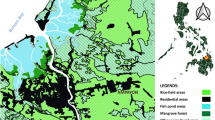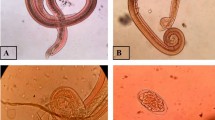Abstract
The study was to understand the Angiostrongylus cantonensis infectious situation of rodent definitive host, snail intermediate host, and local residents in the west-central region of Guangdong Province in China. The snails Achatina fulica and Pomacea canaliculata collected from the survey place were digested with artificial gastric juice, and the third-stage larvae of A. cantonensis in the snails were examined under microscope. The heart and lung of rats captured from the survey place were taken to check the adult of A. cantonensis. The questionnaire surveys related to the infection of A. cantonensis were taken in local residents randomly selected, and the IgG antibody against A. cantonensis was tested in those residents with enzyme-linked immunosorbent assay (ELISA). A total of 1,391 rats including eight kinds of rats, such as Rattus norvegicus, Rattus flavipectus, Bandicota indica, Rattus sladeni, Mus musculus, Rattus rattoides, Suncus Murinus, and Rattus confucianus, were examined and 132 of them were infected by A. cantonensis, with an average infection rate of 9.49% and a mean intensity of A. cantonensis in infected rats was 9.39. A total of 3,184 snails A. fulica and 3,723 snails P. canaliculata were detected. The average infection rates of them were 25.03% (797/3,184) and 6.50% (242/3,723), respectively. There were 180 positive samples of IgG antibody against A. cantonensis in 1,800 serum samples of the residents, with a positive rate of 10.00%. The west-central region of Guangdong Province is the natural focus of A. cantonensis. In comparison with the investigation results in other regions of China, the infection rate of rat definitive host is at the middle level; in the intermediate host, the infection rate of snail A. fulica is above the middle level, and the infection rate of snail Pomacea canaliculata is below the middle level. Some local residents had already been infected by A. cantonensis or at the risk of being infected.



Similar content being viewed by others
References
Asato R, Taira K, Nakamura M et al (2004) Changing epidemiology of Angiostrongylus cantonensis in Okinawa prefecture, Japan. Jpn J Infect Dis 57:184–186
Carney WP, Stafford EE, Purnomo TS (1978) Angiostrongyliasis in Indonesia: additional geographic and host occurrence records. Southeast Asian J Trop Med Public Health 9:516–519
Deng ZH, Cai JS, Lin RX et al (2007) The first local outbreak of Angiostrongylus cantonensis infection in Guangdong province. South China J Prev Med 33(4):17–20
Gan SB (2007) Angiostrongylus cantonensis. World J Infect 7(2):93–96
He JZ, Zhu SH, Yang SJ et al (1984) First discover and evidence of Angiostrongylus cantonensis in the cerebrospinal fluid from the case of the population of the mainland China. Acad J Guangzhou Med Coll 12(3):1–4
Hu XM, Tong CJ, Liu J, Wang SQ (2007) Survey of epidemic focus of Angiostrongylus cantonensis in Hainan Province. China Trop Med 7(11):1995–1996
Hüttemann M, Schmahl G, Mehlhorn H (2007) Light and electron microscopic studies on two nematodes, Angiostrongylus cantonensis and Trichuris muris, differing in their mode of nutrition. Parasitol Res 101(Suppl 2):S225–S232
Jin H, He X, Liu DX et al (2006) Dynamic observation on the serum IgG level in rats infected with Angiostrongylus cantonensis. China Trop Med 6(1):21–22, 27
Ko RC, Chan SW, Chan KW et al (1987) Four documented cases of eosinophilic meningoencephalitis due to Angiostrongylus cantonensis in Hong Kong. Trans R Soc Trop Med Hyg 81(5):807–810
Li LS, Zhou XN, Lin JX et al (2006) Discovery of the new hosts for six species of Angiostrongylus cantonensis and investigation on the epidemic foci in Fujian province. Chin J Zoonoses 22(6):533–537
Li FH, Zhou XM, Li YZ, Tao H (2008a) Investigation on epidemic focus of Angiostrongylus cantonensis in Yunnan Province, China. J Pathogen Biol 3(1):53–56, 18
Li H, Xu F, Gu JB, Chen XG (2008b) A severe eosinophilic meningoencephalitis caused by infection of Angiostrongylus cantonensis. Am J Trop Med Hyg 79(4):568–570
Liang HK, Sheng HX, Xu BK (1984) Survey on the infection situation of definitive host, intermediate host and transport host of Angiostrongylus cantonensis in Guangzhou city. Chin J Epidemiol 5(4):245–248
Lin JX, Li YS, Zhu K et al (2003) Epidemiological study on group infection of Angiostrongylus cantonensis in Changle City. Chin J Parasitol Parasit Dis 21:110–112
Lin RX, Deng ZH, Wen XM et al (2008) Investigation on the source of angiostrongyliasis in Luoding city, Guangdong province. J Trop Med 8(1):61–63
Lindo JF, Waugh C, Hall J et al (2002) Enzootic Angiostrongylus cantonensis in rats and snails after an outbreak of human eosinophilic meningitis, Jamaica. Emerg Infect Dis 8(3):324–326
Luo B, Chen JY, Ye DG et al (2005) Study of Angiostrongylus cantonensis foci in Fuzhou City. Chin J Zoonoses 21(9):829–830
Lv S, Zhang Y, Steinmann P, Zhou XN (2008) Emerging angiostrongyliasis in Mainland China. Emerg Infect Dis 14(1):161–164
Lv S, Zhang Y, Chen SR et al (2009) Human angiostrongyliasis outbreak in Dali. China PLoS Negl Trop Dis 3(9):e520
Pan CW, Ling HB, Liang SH et al (2000) Clinical and epidemiological study on angiostrongyliasis in Wenzhou district. Natl Med J China 80(3):204–205
Pipitgool V, Sithithaworn P, Pongmuttasaya P, Hinz E (1997) Angiostrongylus infections in rats and snails in northeast Thailand. Southeast Asian J Trop Med Public Health 28(Suppl 1):190–193
Qu ZY, Zhan XM, He A (2007) The analysis on epidemic situation of angiostrongyliasis in China. Int J Med Parasit Dis 34(5):279–283
Scrimgeour EM (1984) Distribution of Angiostrongylus cantonensis in Papua New Guinea. Trans R Soc Trop Med Hyg 78(6):776–779
Tsai HC, Liu YC, Kunin CM et al (2001) Eosinophilic meningitis caused by Angiostrongylus cantonensis: report of 17 cases. Am J Med 111:109–114
Uga S, Ono K, Kataoka N et al (1996) Seroepidemiology of five major zoonotic parasite infections in inhabitants of Sidoarjo, East Java, Indonesia. Southeast Asian J Trop Med Public Health 27(3):556–561
Wang QP, Chen XG, Lun ZR (2007) Invasive freshwater snail, China. Emerg Infect Dis 13:1119–1120
Wang QP, Lai DH, Zhu XQ et al (2008) Human angiostrongyliasis. Lancet Infect Dis 8(10):621–630
Wang J, Qi H, Diao Z et al (2010) An outbreak of Angiostrongylus cantonensis in Beijing. J Parasitol 96(2):377–381
Xing WL, Pan CW, Liang SH et al (1998) Study on distribution of Angiostrongylus cantonensis larvae in Pomacea canaliculata from Wenzhou. J Wenzhou Med Coll 28(4):297–298
Xue DY, Ruan YZ, Lin BC et al (2000) Epidemiplogical investigation on an outbreak of Angiostrongylus cantonensis in Wenzhou. Chin J Parasitol Parasit Dis 18(3):176–178
Yan P, Chen GH, Zhang MD et al (1997) A autopsy report of the case with angiostrongyliasis. Chin J Pathol 26(2):128
Yang FZ, Zhang YZ, Tu ZP, Huang XH (2003) Epidemiological survey on Angiostrongylus cantonensis in Fujian province. J Trop Dis Parasitol 1(2):80–82
Yen CM, Chen ER, Cheng CW (1990) A survey of Ampullarium canaliculatus for natural infection of Angiostrongylus cantonensis in south Taiwan. J Trop Med Hyg 93(5):347–350
Zhang HM, Tan YG, Li XM et al (2007) Survey on the infectious focus of Angiostrongylus cantonensis in Guangxi. J Trop Dis Parasitol 5(2):79–84
Zhu TC, Shen HX, Ye XG, Ding BL (1993) Investigation of rats definitive host of Angiostrongylus cantonensis at Friendly farm in Xuwen county of Guangdong province. Chin J Zoonoses 9(6):36–37
Acknowledgments
This work was supported by the grants from the National Natural Science Foundation of P.R. China (U0632003) and science and technology plan projects of Guangdong Province (2010B060500017).
Author information
Authors and Affiliations
Corresponding author
Rights and permissions
About this article
Cite this article
Chen, D., Zhang, Y., Shen, H. et al. Epidemiological survey of Angiostrongylus cantonensis in the west-central region of Guangdong Province, China. Parasitol Res 109, 305–314 (2011). https://doi.org/10.1007/s00436-011-2255-1
Received:
Accepted:
Published:
Issue Date:
DOI: https://doi.org/10.1007/s00436-011-2255-1




